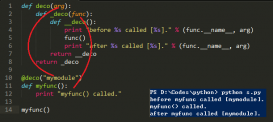Python ORM 概览
作为一个美妙的语言,Python 除了 SQLAlchemy 外还有很多ORM库。在这篇文章里,我们将来看看几个流行的可选ORM 库,以此更好地窥探到Python ORM 境况。通过写一段脚本来读写2个表 ,person 和 address 到一个简单的数据库,我们能更好地理解每个ORM库的优缺点。
SQLObject
SQLObject 是一个介于SQL数据库和Python之间映射对象的Python ORM。得益于其类似于Ruby on Rails的ActiveRecord模式,在编程社区变得越来越流行。首个 SQLObject在2002年十月发布。它遵循LGPL许可。
在 SQLObject 中,数据库概念是通过与 SLQAlchemy 非常类似的的一种方式映射到Python的,表映射成类,行作为实例而字段作为属性。它同时提供一种基于Python对象的查询语言,这使得SQL 更加抽象, 从而为应用提供了数据库不可知性(译注:应用和数据库分离)
|
1
2
3
4
5
6
7
8
9
10
11
12
13
14
15
16
17
18
19
20
21
22
23
24
25
26
27
28
29
30
31
32
33
34
35
36
37
38
|
$ pip install sqlobjectDownloading/unpacking sqlobjectDownloading SQLObject-1.5.1.tar.gz (276kB): 276kB downloadedRunning setup.py egg_info for package sqlobject warning: no files found matching '*.html'warning: no files found matching '*.css'warning: no files found matching 'docs/*.html'warning: no files found matching '*.py' under directory 'tests'Requirement already satisfied (use --upgrade to upgrade): FormEncode>=1.1.1 in /Users/xiaonuogantan/python2-workspace/lib/python2.7/site-packages (from sqlobject)Installing collected packages: sqlobjectRunning setup.py install for sqlobjectchanging mode of build/scripts-2.7/sqlobject-admin from 644 to 755changing mode of build/scripts-2.7/sqlobject-convertOldURI from 644 to 755 warning: no files found matching '*.html'warning: no files found matching '*.css'warning: no files found matching 'docs/*.html'warning: no files found matching '*.py' under directory 'tests'changing mode of /Users/xiaonuogantan/python2-workspace/bin/sqlobject-admin to 755changing mode of /Users/xiaonuogantan/python2-workspace/bin/sqlobject-convertOldURI to 755Successfully installed sqlobjectCleaning up... >>> from sqlobject import StringCol, SQLObject, ForeignKey, sqlhub, connectionForURI>>> sqlhub.processConnection = connectionForURI('sqlite:/:memory:')>>>>>> class Person(SQLObject):... name = StringCol()...>>> class Address(SQLObject):... address = StringCol()... person = ForeignKey('Person')...>>> Person.createTable()[]>>> Address.createTable()[] |
上面的代码创建了2个简单的表:person 和 address 。为了创建和插入记录到这2个表,我们简单实例化一个person 实例和 一个 address 实例:
|
1
2
3
4
5
6
7
|
>>> p = Person(name='person')>>> a = Address(address='address', person=p)>>> p >>> a <address> |
为了获得或检索新记录, 我们用神奇的 q 对象关联到 Person 和 Address 类:
|
1
2
3
4
5
6
7
8
9
10
11
12
13
14
15
16
17
18
19
|
>>> persons = Person.select(Person.q.name == 'person')>>> persons >>> list(persons)[]>>> p1 = persons[0]>>> p1 == pTrue>>> addresses = Address.select(Address.q.person == p1)>>> addresses >>> list(addresses)[ <address>]>>> a1 = addresses[0]>>> a1 == aTrue |
Storm 是一个介于 单个或多个数据库与Python之间 映射对象的 Python ORM 。为了支持动态存储和取回对象信息,它允许开发者构建跨数据表的复杂查询。它由Ubuntu背后的公司 Canonical公司用Python开发的,用在 Launchpad 和 Landscape 应用中,后来在2007年作为自由软件发布。这个项目在LGPL许可下发布,代码贡献者必须受让版权给Canonical公司。
像 SQLAlchemy 和 SQLObject 那样, Storm 也映射表到类,行到实例和字段到属性。相对另外2个库, Stom中 table class 不需要是框架特定基类 的子类 。在 SQLAlchemy中,每个 table class 是 sqlalchemy.ext.declarative.declarative_bas 的一个子类。 而在SQLOjbect中,每个table class是 的 sqlobject.SQLObject 的子类。
类似于 SQLAlchemy, Storm 的 Store 对象对于后端数据库就像一个代理人, 所有的操作缓存在内存,一当提交方法在store上被调用就提交到数据库。每个 store 持有自己的Python数据库对象映射集合,就像一个 SQLAlchemy session 持有不同的 Python对象集合。
指定版本的 Storm 可以从 下载页面 下载。在这篇文章里,示例代码是使用 0.20 版本的Storm写的。
|
1
2
3
4
5
6
7
8
9
10
11
12
13
14
15
16
17
18
19
20
|
>>> from storm.locals import Int, Reference, Unicode, create_database, Store>>>>>>>>> db = create_database('sqlite:')>>> store = Store(db)>>>>>>>>> class Person(object):... __storm_table__ = 'person'... id = Int(primary=True)... name = Unicode()...>>>>>> class Address(object):... __storm_table__ = 'address'... id = Int(primary=True)... address = Unicode()... person_id = Int()... person = Reference(person_id, Person.id)... |
上面的代码创建了一个 sqlite 内存数据库,然后用 store 来引用该数据库对象。一个Storm store 类似 SQLAlchemy的 DBSession对象,都管理 附属于其的实例对象 的生命周期。例如,下面的代码创建了一个 person 和 一个 address, 然后通过刷新 store 都插入记录。
|
1
2
3
4
5
6
7
8
9
10
11
12
13
14
15
16
17
18
19
20
21
22
23
24
25
26
27
28
29
30
31
32
|
>>> store.execute("CREATE TABLE person "... "(id INTEGER PRIMARY KEY, name VARCHAR)") >>> store.execute("CREATE TABLE address "... "(id INTEGER PRIMARY KEY, address VARCHAR, person_id INTEGER, "... " FOREIGN KEY(person_id) REFERENCES person(id))") >>> person = Person()>>> person.name = u'person'>>> print person >>> print "%r, %r" % (person.id, person.name)None, u'person' # Notice that person.id is None since the Person instance is not attached to a valid database store yet.>>> store.add(person) >>> print "%r, %r" % (person.id, person.name)None, u'person' # Since the store hasn't flushed the Person instance into the sqlite database yet, person.id is still None.>>> store.flush()>>> print "%r, %r" % (person.id, person.name)1, u'person' # Now the store has flushed the Person instance, we got an id value for person.>>> address = Address()>>> address.person = person>>> address.address = 'address'>>> print "%r, %r, %r" % (address.id, address.person, address.address)None, , 'address'>>> address.person == personTrue>>> store.add(address) >>> store.flush()>>> print "%r, %r, %r" % (address.id, address.person, address.address)1, , 'address' |
为了获得或检索已插的 Person 和 Address 对象, 我们调用 store.find() 来查询:
|
1
2
3
4
5
6
7
8
|
>>> person = store.find(Person, Person.name == u'person').one()>>> print "%r, %r" % (person.id, person.name)1, u'person'>>> store.find(Address, Address.person == person).one() >>> address = store.find(Address, Address.person == person).one()>>> print "%r, %r" % (address.id, address.address)1, u'address' |
Django 的 ORM
Django 是一个免费开源的紧嵌ORM到其系统的web应用框架。在它首次发布后,得益于其易用为Web而备的特点,Django越来越流行。它在2005年七月在BSD许可下发布。因为Django的ORM 是紧嵌到web框架的,所以就算可以也不推荐,在一个独立的非Django的Python项目中使用它的ORM。
Django,一个最流行的Python web框架, 有它独有的 ORM。 相比 SQLAlchemy, Django 的 ORM 更吻合于直接操作SQL对象,操作暴露了简单直接映射数据表和Python类的SQL对象 。
|
1
2
3
4
5
6
7
8
9
10
11
12
13
14
15
16
17
18
19
20
|
$ django-admin.py startproject demo$ cd demo$ python manage.py syncdbCreating tables ...Creating table django_admin_logCreating table auth_permissionCreating table auth_group_permissionsCreating table auth_groupCreating table auth_user_groupsCreating table auth_user_user_permissionsCreating table auth_userCreating table django_content_typeCreating table django_session You just installed Django's auth system, which means you don't have any superusers defined.Would you like to create one now? (yes/no): noInstalling custom SQL ...Installing indexes ...Installed 0 object(s) from 0 fixture(s)$ python manage.py shell |
因为我们在没有先建立一个项目时不能够执行Django代码,所以我们在前面的shell创建一个Django demo 项目,然后进入Django shell来测试我们写的 ORM 例子。
|
1
2
3
4
5
6
7
8
9
10
11
12
13
14
15
16
|
# demo/models.py>>> from django.db import models>>>>>>>>> class Person(models.Model):... name = models.TextField()... class Meta:... app_label = 'demo'...>>>>>> class Address(models.Model):... address = models.TextField()... person = models.ForeignKey(Person)... class Meta:... app_label = 'demo'... |
上面的代码声明了2个Python 类,Person 和 Address,每一个都映射到数据库表。在执行任意数据库操作代码之前,我们需要先在本地的sqlite数据库创建表。
|
1
2
3
4
5
6
7
|
python manage.py syncdbCreating tables ...Creating table demo_personCreating table demo_addressInstalling custom SQL ...Installing indexes ...Installed 0 object(s) from 0 fixture(s) |
为了插入一个 person 和一个 address 到数据库,我们实例化相应对象并调用这些对象的save() 方法。
|
1
2
3
4
5
6
7
8
9
|
>>> from demo.models import Person, Address>>> p = Person(name='person')>>> p.save()>>> print "%r, %r" % (p.id, p.name)1, 'person'>>> a = Address(person=p, address='address')>>> a.save()>>> print "%r, %r" % (a.id, a.address)1, 'address' |
为了获得或检索 person 和 address 对象, 我们用model类神奇的对象属性从数据库取得对象。
|
1
2
3
4
5
6
7
8
9
10
11
12
13
14
|
>>> persons = Person.objects.filter(name='person')>>> persons[]>>> p = persons[0]>>> print "%r, %r" % (p.id, p.name)1, u'person'>>> addresses = Address.objects.filter(person=p)>>> addresses[ <address>]>>> a = addresses[0]>>> print "%r, %r" % (a.id, a.address)1, u'address' |
peewee
peewee 是一个小的,表达式的 ORM。相比其他的 ORM,peewee 主要专注于极简主义,其API简单,并且其库容易使用和理解。
|
1
2
3
4
5
6
7
8
9
10
11
12
|
pip install peeweeDownloading/unpacking peeweeDownloading peewee-2.1.7.tar.gz (1.1MB): 1.1MB downloadedRunning setup.py egg_info for package peewee Installing collected packages: peeweeRunning setup.py install for peeweechanging mode of build/scripts-2.7/pwiz.py from 644 to 755 changing mode of /Users/xiaonuogantan/python2-workspace/bin/pwiz.py to 755Successfully installed peeweeCleaning up... |
为了创建数据库模型映射,我们实现了一个Person 类 和一个Address类 来映射对应的数据库表。
|
1
2
3
4
5
6
7
8
9
10
11
12
13
14
15
16
17
18
|
>>> from peewee import SqliteDatabase, CharField, ForeignKeyField, Model>>>>>> db = SqliteDatabase(':memory:')>>>>>> class Person(Model):... name = CharField()... class Meta:... database = db...>>>>>> class Address(Model):... address = CharField()... person = ForeignKeyField(Person)... class Meta:... database = db...>>> Person.create_table()>>> Address.create_table() |
为了插入对象到数据库,我们实例化对象并调用了它们的save() 方法。从视图的对象创建这点来看,peewee类似于Django。
|
1
2
3
4
|
>>> p = Person(name='person')>>> p.save()>>> a = Address(address='address', person=p)>>> a.save() |
为了从数据库获得或检索对象, 我们select 了类各自的对象。
|
1
2
3
4
5
6
7
8
|
>>> person = Person.select().where(Person.name == 'person').get()>>> person >>> print '%r, %r' % (person.id, person.name)1, u'person'>>> address = Address.select().where(Address.person == person).get()>>> print '%r, %r' % (address.id, address.address)1, u'address' |
SQLAlchemy
SQLAlchemy 是Python编程语言里,一个在MIT许可下发布的开源工具和SQL ORM。它首次发布于2006年二月,由Michael Bayer写的。它提供了 “一个知名企业级的持久化模式的,专为高效率和高性能的数据库访问设计的,改编成一个简单的Python域语言的完整套件”。它采用了数据映射模式(像Java中的Hibernate)而不是Active Record模式(像Ruby on Rails的ORM)。
SQLAlchemy 的工作单元 主要使得 有必要限制所有的数据库操作代码到一个特定的数据库session,在该session中控制每个对象的生命周期 。类似于其他的ORM,我们开始于定义declarative_base()的子类,以映射表到Python类。
|
1
2
3
4
5
6
7
8
9
10
11
12
13
14
15
16
17
18
19
20
21
|
>>> from sqlalchemy import Column, String, Integer, ForeignKey>>> from sqlalchemy.orm import relationship>>> from sqlalchemy.ext.declarative import declarative_base>>>>>>>>> Base = declarative_base()>>>>>>>>> class Person(Base):... __tablename__ = 'person'... id = Column(Integer, primary_key=True)... name = Column(String)...>>>>>> class Address(Base):... __tablename__ = 'address'... id = Column(Integer, primary_key=True)... address = Column(String)... person_id = Column(Integer, ForeignKey(Person.id))... person = relationship(Person)... |
在我们写任何数据库代码前,我们需要为数据库session创建一个数据库引擎。
|
1
2
|
>>> from sqlalchemy import create_engine>>> engine = create_engine('sqlite:///') |
一当我们创建了数据库引擎,可以继续创建一个数据库会话,并为所有之前定义的 Person和Address 类创建数据库表。
|
1
2
3
4
|
>>> from sqlalchemy.orm import sessionmaker>>> session = sessionmaker()>>> session.configure(bind=engine)>>> Base.metadata.create_all(engine) |
现在,session 对象对象变成了我们工作单元的构造函数,将和所有后续数据库操作代码和对象关联到一个通过调用它的 __init__() 方法构建的数据库session上。
|
1
2
3
4
5
|
>>> s = session()>>> p = Person(name='person')>>> s.add(p)>>> a = Address(address='address', person=p)>>> s.add(a) |
为了获得或检索数据库中的对象,我们在数据库session对象上调用 query() 和 filter() 方法。
|
1
2
3
4
5
6
7
8
|
>>> p = s.query(Person).filter(Person.name == 'person').one()>>> p >>> print "%r, %r" % (p.id, p.name)1, 'person'>>> a = s.query(Address).filter(Address.person == p).one()>>> print "%r, %r" % (a.id, a.address)1, 'address' |
请留意到目前为止,我们还没有提交任何对数据库的更改,所以新的person和address对象实际上还没存储在数据库中。 调用 s.commit() 将会提交更改,比如,插入一个新的person和一个新的address到数据库中。
|
1
2
|
>>> s.commit()>>> s.close() |
Python ORM 之间对比
对于在文章里提到的每一种 Python ORM ,我们来列一下他们的优缺点:
SQLObject
优点:
- 采用了易懂的ActiveRecord 模式
- 一个相对较小的代码库
缺点:
- 方法和类的命名遵循了Java 的小驼峰风格
- 不支持数据库session隔离工作单元
Storm
优点:
- 清爽轻量的API,短学习曲线和长期可维护性
- 不需要特殊的类构造函数,也没有必要的基类
缺点:
- 迫使程序员手工写表格创建的DDL语句,而不是从模型类自动派生
- Storm的贡献者必须把他们的贡献的版权给Canonical公司
Django's ORM
优点:
- 易用,学习曲线短
- 和Django紧密集合,用Django时使用约定俗成的方法去操作数据库
缺点:
- 不好处理复杂的查询,强制开发者回到原生SQL
- 紧密和Django集成,使得在Django环境外很难使用
peewee
优点:
- Django式的API,使其易用
- 轻量实现,很容易和任意web框架集成
缺点:
- 不支持自动化 schema 迁移
- 多对多查询写起来不直观
SQLAlchemy
优点:
- 企业级 API,使得代码有健壮性和适应性
- 灵活的设计,使得能轻松写复杂查询
缺点:
- 工作单元概念不常见
- 重量级 API,导致长学习曲线
总结和提示
相比其他的ORM, SQLAlchemy 意味着,无论你何时写SQLAlchemy代码, 都专注于工作单元的前沿概念 。DB Session 的概念可能最初很难理解和正确使用,但是后来你会欣赏这额外的复杂性,这让意外的时序提交相关的数据库bug减少到0。在SQLAlchemy中处理多数据库是棘手的, 因为每个DB session 都限定了一个数据库连接。但是,这种类型的限制实际上是好事, 因为这样强制你绞尽脑汁去想在多个数据库之间的交互, 从而使得数据库交互代码很容易调试。
在未来的文章中,我们将会完整地披露更高阶的SQLAlchemy用例, 真正领会无限强大的API。












